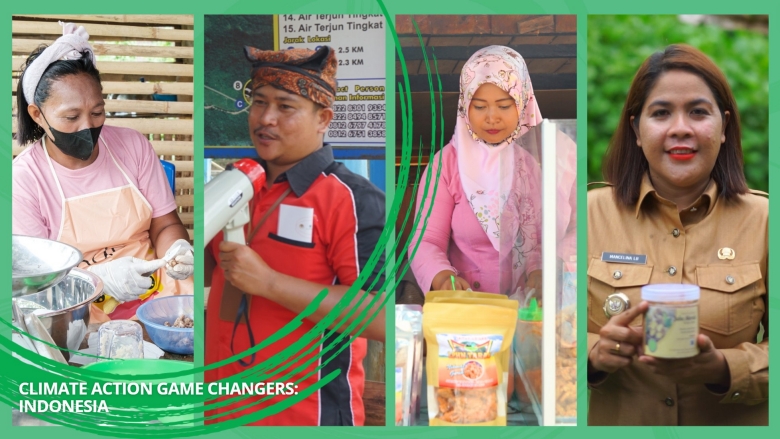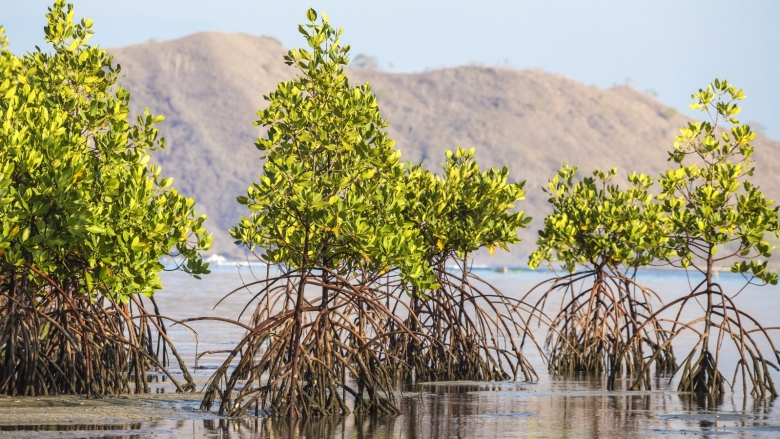Indonesia Sustainable Landscapes Management Program (SLMP)
Climate Action Game Changers: The Forest Story from Indonesia
In Indonesia, indigenous peoples and local communities are gaining gradual access to sustainable forest management, bolstering climate protection and livelihoods. Discover the impact in this feature story.
Immersive Story: Forest for Us: Game Changers for a Livable Planet
Investing in our forests can reduce poverty, unlock inclusive economies, and promote nature-resilient futures. Read our immersive story to understand how we are supporting forest economies around the world, including voices from the Colombian Amazon, Ghana, Democratic Republic of the Congo, and Indonesia.
Feature Story: Planting Mangrove Forests Is Paying Off in Indonesia
Incentivizing local residents to plant mangroves has raised incomes, increased fishery output, protected coastal areas, and contributed to efforts in mitigating climate change.
Feature Story: From the Ground Up: How Secure Land Rights Are Improving Livelihoods and Supporting the Climate Agenda in Indonesia
Clarity over land rights and land use has long been recognized as key to sustainable landscape management, social stability, inclusive growth, conflict resolution, and environmental conservation. This story shows how the World Bank-supported project, Program to Accelerate Agrarian Reform, supported participatory mapping and registration of land rights in Pasuruan Regency, East Java, and its impact on communities’ livelihoods. Read the story here.
Feature Story: Knowledge Exchange on National Policies and Large-scale Jurisdictional Programs to Reduce Deforestation and Forest Fires
Brazil, the Democratic Republic of the Congo (DRC), and Indonesia share the challenge of reconciling economic growth in agriculture, timber, mining, and urban development, with protection of their forests and the services they deliver. Their common goals and challenges, despite very different contexts, lead to opportunities for collaboration and knowledge sharing. Recognizing these opportunities, the World Bank facilitated a South-South knowledge exchange between Brazil, Indonesia and DRC in May 2023 to strengthen the knowledge and understanding of policy makers in the three countries to reduce deforestation and to build successful large-scale jurisdictional programs. Read more about the knowledge exchange in the recent result story published on the South South Facility website.
Photo credit: World Bank, 2023
Feature Story: Protecting Forests and Improving Livelihoods in Indonesia
This story highlights lessons learned from World Bank’s support to the Government of Indonesia in strengthening local sustainable forest management activities, which can contribute to Indonesia’s Forest and Land Use (FOLU) net sink agenda. This includes lessons from the Forest Investment Program II (FIP II) that aims to strengthen Forest Management Units (FMUs) across Indonesia and the Strengthening Rights and Economies of Adat and Local Communities Project (also known as the Dedicated Grant Mechanism Indonesia/ DGMI) that worked with Indigenous Peoples and Local Communities to achieve legal access to land.
Press Release: Indonesia Receives First Payment for Reducing Emissions in East Kalimantan
On November 8, Indonesia received an advance payment of US$20.9 million (IDR 320 billion) under the Emissions Reduction Payment Agreement between the Government of Indonesia and the World Bank’s Forest Carbon Partnership Facility (FCPF) for reducing emissions from deforestation and forest degradation (REDD+) in East Kalimantan province. Under the Agreement, Indonesia would receive up to US$110 million (IDR1.6 trillion) for verified emissions from reducing deforestation and forest degradation.
Indonesia has become the first country in the East Asia Pacific region to receive payments through the World Bank’s FCPF, which represents 13.5 percent of the value of the emissions reduction reported in the Government of Indonesia’s Monitoring Report for the 2019-2020 crediting period. The full payment will be released once the independent third-party verification of the reported emissions reductions, which is currently ongoing, is complete.
Photo credit: World Bank/ Efrian M.
Blog: Indonesia’s green belt – Protecting and restoring the country’s mangroves
Indonesia harbors the largest area and diversity of mangrove ecosystems in the world. Mangroves support coastal, protect the country’s coasts from disasters, and store 3.14 billion tons of CO2. Read more on how Indonesia could protect this important ecosystem.
Blog: How Jambi province could become the role model of sustainable landscapes in Indonesia
Jambi has established a provincial Green Growth Plan to promote sustainable and inclusive growth. The International Day of Forests this year takes us back to memory lane when World Bank staffs made a personal visit to the province’s capital Jambi City, located in eastern Jambi, to the Kerinci district in the province’s far west of Jambi.
Blog: Indonesia’s ‘Green Belt’ - Mangroves for local and global benefits
Indonesia is home to 3.36 million hectares of mangroves, over 20 percent of the world’s mangrove ecosystems. This blog story highlights the need for a landscape approach to mangrove management by taking a holistic approach – not only restoring mangroves through planting, but also ensuring that existing mangroves are managed sustainably through incentives to local communities, enforcement of regulations and spatial planning.
Feature Story: Opening the Door to Community Forest Access and Management in Indonesia
In Indonesia’s West Kalimantan Province, the people of Padang Tikar village manage 76,000 hectares of mangrove forests. Their agroforestry-based businesses and honeybees earn monthly profits for them of about IDR 325 million (US$ 22,000) – an example of how legal access to forest use provides significant benefits to rural people. This story, recounted in Tosca Santoso’s 2019 book “Lima Hutan, Satu Cerita” (“Five Forest, One Story”), describes one of many ways communities can thrive when given legal access to manage forests sustainably.
Feature Story: Mangrove Conservation and Restoration: Protecting Indonesia’s “Climate Guardians”
As the guardians of local homes and livelihoods, mangroves provide shoreline protection from storms and tsunamis, reduce flood-risks, inundation, and erosion. Mangroves also store significant amounts of carbon. Discover the various efforts already underway - by the Government as well as communities - to sustainably manage this important ecosystem.
Blog: Indonesia Can Build Back Better for A Green Recovery
When the 2004 earthquake and tsunami wiped out homes, buildings, and roads in Aceh, the government was confronted with two options: build everything back to pre-disaster conditions or seize the opportunity to ‘build back better’. They chose the latter, prioritizing the needs of local communities while ensuring resilience to future disasters. Today, as the global economy reels from the effects of the pandemic, leaders are being asked the same question: can we design a recovery that not only saves lives and generates growth, but that is also resilient and sustainable over the long term?
Blog: Landscape approach in Indonesia: From concept to a practical tool to reduce greenhouse gas emissions and improve livelihoods
A healthy environment is a prerequisite for the economy to thrive. An integrated landscape management that brings together communities, government, private sectors, and civil society partners can balance multiple demands for lands in a way that considers food and livelihoods, land rights, restoration and progress towards climate and development goals. Read the blog on how the integrated landscape management comes into practice
Feature Story: The Win-Win of Forest Protection: Enhancing Lives While Slowing Climate Change
The 21st century has seen a surge in governments’ strategic protection of forests, for good reason. Forest protection enhances people’s lives while slowing climate change by enabling trees, soil and grasslands to perform their natural functions of removing carbon dioxide from the atmosphere. The World Bank’s $3.7 billion portfolio of 102 forest projects supports systemic, transformative engagement to reduce climate change and supports forest programs in more than 50 countries, including Jambi, Ghana, Indonesia, Lao Peoples Democratic Republic, Mexico, Mozambique, Nepal, Vietnam and Zambia.
Feature Story: Indonesia takes a landscape approach to reduce deforestation, address climate change
In Sumatra, deforestation threatens globally significant tropical forests and biodiversity. To address the drivers across a variety of sectors, the Government of Indonesia is developing a unique landscape management approach in Jambi that can be used as a model for reducing land-use emissions across the country.
Press release: Indonesia and the World Bank sign milestone agreement on emission reductions
On November 27, 2020, Indonesia’s Ministry of Environment and Forestry (MoEF) and the World Bank’s Forest Carbon Partnership Facility (FCPF) signed a landmark agreement to unlock up to US$110 million to lower carbon emissions from deforestation and forest degradation until 2025.
Blog: Partnerships, cornerstone to achieve Indonesia’s sustainable peatland restoration targets
World Bank insights from the high-panel discussion in “Global Landscapes Forum: Peatlands Matter” held in May 2017 on why developing a stronger partnership among government, private sector and civil society is the cornerstone to achieve Indonesia’s peatland restoration target.
Blog: Controlling the Burn: Indonesia’s efforts to prevent forest and land fire crisis
Forest and land fires have been an annual man-made event with some 2,356 hotspots detected in Sumatra and Kalimantan between January and August 2016. How to prevent it happening again in the future?
Blog: Seeing the Impact of Forest Fires in South Sumatra: A View from the Field
An experience from the field on how to find success in Sustainable landscape management in Indonesia: Supporting smallholders while securing Government’s actions to restore development of peatlands – a key step in the right direction.




















